From a young age and till this day, sunsets and sunrises have always been my go-to art picture. They were and are usually presented through paintings, drawings, photographs and sounds. My favourite part of any vacation is to watch the timeless moments of waiting for the sun to rise or the endless affects of sunsets. This is my inspiration because everyday starts with a sunrise and a sunset. No matter where you are in the world, you will still have the same feeling as if you were home and watching the sun. I choose to paint or draw sunsets because I feel as if the colours that are associated resemble a calm presence. By mixing the colours I am choosing to blend the surrounding scenery to blend into the sun’s shadow. I would love to broaden my horizon by venturing out of the sunrise/sunset drawings, but for me art is to calm the mind and that is exactly what sun images do for me.
Méret Elisabeth Oppenheim
Méret Elisabeth Oppenheim was born on October 6, 1913 in Germany, yet grew up in Switzerland. She joined the Surrealists and began to create sculptures. Oppenheim’s sculptures embraced feminine domestic object, but with a twist. She would specifically underline how one household item can be used in an entirely different way or by adding other materials that usually do not belong to the item. For instance, her fur-covered cup is one of her famous sculptures. Oppenheim was one of the first female members in the Surrealists group and brought these sculptures to present different forms of an object.
Kurt Schwitters
Kurt Schwitters was born on June 20, 1887 in Germany. He studied art and drawing at Dresden Academy from 1909-1915. Schwitters began his artistic journey by collecting garbage and turning it into art masterpieces. He began his ventures after World War I and used his creative building by finding materials around him. With the garbage, Schwitters would directly place the pieces of garbage onto his current works. Through these art pieces, he would create collages that would incorporate his artistic mind and the media’s printed works. He later created journals, advertisement and he founded the Merz journal.
Brian Jungen
Brian Jungen is a Canadian artist known for his contemporary art, who currently is living and working in the North Okanagan of British Columbia. He creates sculptures out of a variety of materials that are considered everyday. Many of his sculptures take the form of traditional Aboriginal art forms, or resemble standard tools, and components of Aboriginal cultures. By combining everyday, very mainstream, materialistic, and superfluous, he is able to create and highlight the juxtaposition between the materialistic modern culture we currently experience, and its cohabitation with Aboriginal cultures. He has made things such as totems, and masks, out of sporting goods, such as golf balls, and has an installation in the National Gallery of Canada that is a whale created out of plastic lawn chairs.
Hajra Waheed
Hajra Waheed is a Canadian artist from Montreal who works with various medias (from collage, to video, sound and sculpture) to explore issues around covert power, mass surveillance, cultural distortion, other other traumas faced by displaced subjects through mass migration. She uses extensive research and new accounts to prompt and support her work. She expresses her work in a variety of ways. For instance, since 2008 she has been working on an ongoing series called the Anouchian Passport Portrait Series. She created renderings, drawn in pencil and charcoal that mimics the automated movements of a printer, of men and women whose pictures were taken by an Armenia photographer, Antranik Anounchian. She also has done video installations, and other medias throughout her career.
http://hajrawaheed.com/works/
Artist Profiles
Here are various profiles of artists that we looked at in this course.
Our Favourite Inspirations
Every member of the Fuchsia Friends has found throughout our art class, that we each have something we prefer to work with artistically. These different things are our favourite things to find inspiration with, and to express in various forms of media.
Working on E&P in Class
In our second to last class the Fuchsia Friends worked together to find examples of different Elements and Principles of Design in various magazines and other forms of print.
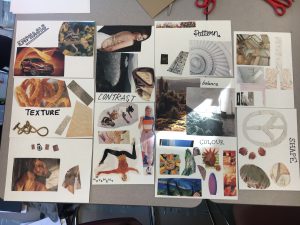
Some of our Art Work through the Semester
MAKING OUR FUSCHIA COLLAGE
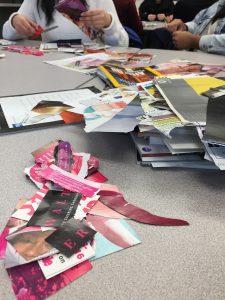

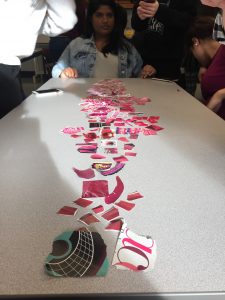

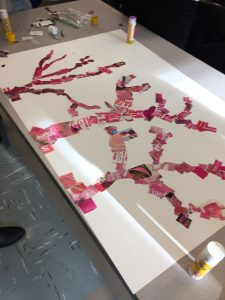
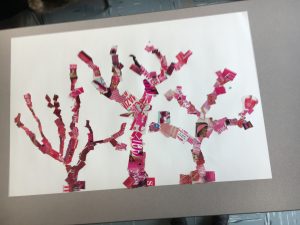
OUR OUTDOOR PIECE

SOME OF OUR CERAMICS
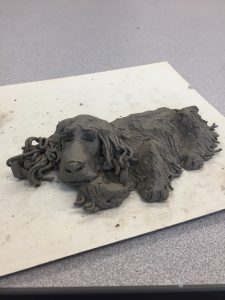

TEMPERA FRAMES
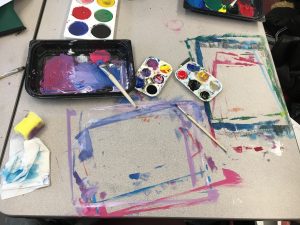
OUR CULTURAL TAPESTRY
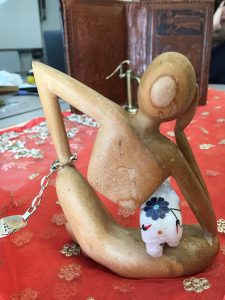
OUR FUCHSIA FEATHERED FRIENDS – a directed drawing activity

WORKING WITH FABRICS

Hello world!
Welcome to UBC Blogs. This is your first post. Edit or delete it, then start blogging!